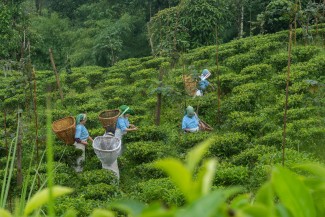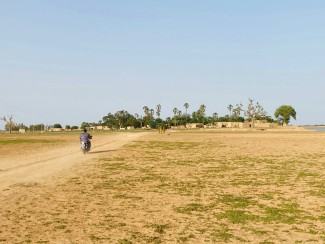International Food Policy Research Institute (IFPRI) Senior Research Fellow discusses agriculture-based economies and how the current US-China trade situation is affecting the world’s poor
How are the current trade tensions impacting food security in the world’s developing countries?
In order to understand the dilemma around food security, we have to think on the one hand that it’s about people’s income and on the other hand it’s how international markets and food prices evolve. The trade tensions are going to have an impact on both aspects, including for people in developing economies.
If you have less growth in China, in the United States (US) or in the European Union (EU), it also means that global demand is going down and therefore for many products that are exported by poor economies it’s going to lower prices and it’s going to reduce incomes.
These trade tensions are going to hurt everyone, including the poorest people. When we say economic growth is going to be half a percent less than expected, as soon as it accumulates over 10 years that has an impact. And now what we have is a specific perturbation of agricultural markets because the trade tensions between the US and China have been intense with agriculture because that is the main export from the US to China.
And here there is a more contrasted story because it means that with both the US and the Chinese markets the conflict between the two can create opportunities for new suppliers. So you start to have people in East Africa selling more soybeans and at a better price to China, and you have people in Central America selling more fish products, or people in Southeast Asia replacing the aquaculture products that China was selling to the US. There are these types of short-run opportunities.
Of course, we have to be careful because short-run opportunities may not be long-term gains, because actually these trade tensions can also lead to first a tariff war but then also a subsidy war as we have seen in the US with the government using taxpayer money to compensate farmers for their market losses. And we know that if the large economies are trying to protect their farmers with subsidies, that will depress prices even more and therefore farmers in least developed economies will suffer.
Last but not least, uncertainty is bad overall for investors and economic development. Because you don’t know what will happen tomorrow you may not do some expenditures in agriculture or you may not invest in irrigation in least developed economies because you don’t know if it is going to be a short-run opportunity or not. All this will have an impact on how much money is being put into the agricultural sector to innovate and this can have a great impact on food security in 10 years because we are just not doing the investments now that will be needed in the future, both for the normal trend of food security but also all the issues related to climate change. We need investment now to deal with current problems but also future problems.
Can you give an example of a product that has been disrupted by the current trade uncertainties?
Soybeans are the flagship product exported by the US to China and therefore the one that is the most impacted. At the same time, globally, we need more and more soybeans every year, including in Africa, because soybeans feed livestock and the income growth in developing economies means more dairy and meat consumption. Currently soybeans are the crop that has the highest growth rate in Africa in terms of planted area. We have seen large expansions in southern and eastern Africa but we see it also in Togo in West Africa. So it’s a valuable product that has a role to play in the domestic market in Africa but also is very attractive to export to China.
Here we start to see the complexity, and that short-term instability can create winners and losers. What we have seen is more and more exports from East Africa to China that try to replace US soybeans, but in East Africa initially these soybeans were aimed for the local market. So now you have a problem for many poultry farms that can’t manage to pay the price of soybeans that they were expecting to pay. Why? Because the Chinese demand that is moving from the US to East Africa is pushing soybeans prices up, so if you are a soybean producer that is good news. But if you are starting your poultry business or even your dairy farm that’s pretty bad news. That’s why this instability in the short term can have long-term consequences for another part of the value chain.
At the same time, we have to keep in mind that all these US soybeans have to end up somewhere, and so it starts to be dumped on some markets including in West Africa. So you start to see these flows of soybeans being disrupted. It’s redistributing the cards, but it’s disrupting the African markets in the short run and creating winners and losers.
Agriculture is a risky business, in particular because you deal with weather. But agriculture is also impacted by policy and these days the policy risk can be even more than the weather risk.
Climate change is also creating a lot of uncertainty and disruptions. What impact is this having on the poorest countries and their food security?
I think it’s important to think that the more climate volatility you have, the more price volatility. And trade will be even more and more important. If you have bad weather at home and your harvest has been destroyed or you lose 30% of your harvest you need to get this food from somewhere and world markets are a kind of supermarket, you may like it or not but you are very happy to have a supermarket open 24 hours when you need it. But it will exist only if it always exists. So we need to get these markets operating even more with climate change.
When we want to protect a market from the volatility of global markets actually for small economies we see that domestic price volatility is much higher than global market volatility because the smaller the market, the more volatile it is. If you are in the US or Brazil and one part of the country is hit by bad weather events or a hurricane your overall food production is not jeopardized. As we have seen in Mozambique or Malawi, weather shocks can really hurt 30-40% of production and so prices will skyrocket if they are not stabilized by world markets. Of course sometimes you import volatility but most of the time you stabilize your prices through international markets.
One of the main challenges we see in least developed economies is due to the lack of infrastructure, they are pretty de-connected from most of the food markets. If you look now at the bulk of the food security of African countries in terms of cassava, white maize or tuber roots, they are markets that are very poorly integrated and they are locally volatile.
Part of the low-cost adaptation strategy of climate change starting regionally but even globally is integration to stabilize prices naturally. When we think about resilience, I think we need to think about when we have bad harvests and also when we have good harvests. To make sure that farmers get good income when the weather is bad and when the weather is good, we need to think about this all along the value chain and make sure that when you have a 30% increase in yields because the harvest is perfect you don’t see a price collapse because no one wants to pay for your goods.
Least developed countries' share of global trade is currently less than 1%. Knowing their dependence on agriculture, what can they do?
If you compare their weight in international trade but also their weight in terms of GDP this is not an abnormality. The world economy has grown significantly, China has contributed and most Asian countries have contributed to this large economic expansion, and to an extent the LDCs have stagnated and because they have stagnated, every year their share is smaller and smaller. And we should not forget what they export a lot of oil, minerals, which is not bad in and of itself, but if you export only that this may not trigger inclusive growth.
Agricultural development is one of the most efficient ways to cure poverty. One percent growth in the agriculture sector will reduce poverty by more compared to industrial sectors, if they are the same size.
David Laborde, International Food Policy Research Institute (IFPRI) Senior Research Fellow
Agricultural development is one of the most efficient ways to cure poverty. One percent growth in the agriculture sector will reduce poverty by more compared to industrial sectors, if they are the same size.
The other aspect is that these economies appear to have comparative advantages in agriculture, therefore their share of international trade in agriculture should be bigger than the average size of their economies. But this is not the case.
We have to separate two stories here. One is that they lack productivity gains. When we talk about agriculture most of the value in the trade is in processed or semi-processed food or niche markets and typically nowadays the LDCs are not there. The important aspect is that many LDCs have strong demographic growth and it means that most of the production increases they have are about feeding their population first. Yes, LDCs are pretty small but most of their production is absorbed by the domestic market, so there is not necessarily a surplus to export. So when we assess the performance of LDCs we need to think about their productivity and their market competitiveness, while not forgetting that there are specific dynamics in their domestic markets that are key for their food security.
If you would like to reuse any material published here, please let us know by sending an email to EIF Communications: eifcommunications@wto.org.



